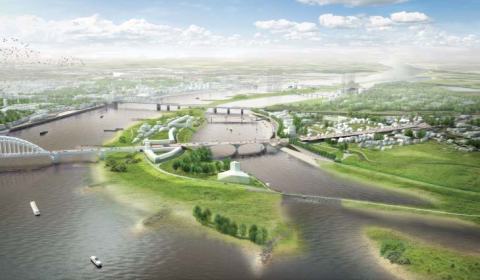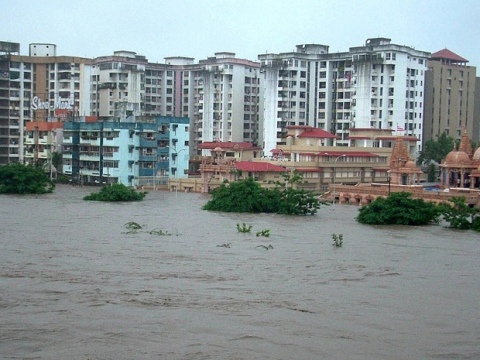Category Archives: climate change
How is the city of Somerville working towards being carbon neutral by 2050 while also adapting to climate change?

Hannah Payne (MCP ’16), the Sustainability Coordinator for the City of Somerville, joins the MIT ClimateX team to discuss these topics and more on Climate Conversations, available here.
Payne has considered the roles of public engagement and collaborative decision-making in crafting plans that will successfully navigate a city through the impacts of climate change. In her thesis, Engaging the public in climate adaptation planning: lessons from sixteen American cities, she identified how cities can collaboratively problem-solving for a climate resilient future by addressing the long-term risks and tradeoffs of adaptation policies. To read her full findings, check out her thesis, available via MIT Libraries on DSpace, here.
ClimateX is an online community focused on climate learning, discussion and action. The community originated from an award winning Climate CoLab proposal by two MIT alumni. To learn more about how the MIT community is attempting to share knowledge, ideas and discuss climate change, check out the ClimateX site, here.
Climate Change Adaptation Planning: the experience of sixteen cities across the U.S.

Hannah Payne, MCP’16, compared the way sixteen cities have tried to engage the public in climate adaptation planning. She identifies three common approaches: 1) including the public in the formulation of broad adaptation strategies, 2) educating the public about climate risks, and 3) promoting collaborative problem-solving for specific climate resilient projects. According to Hannah’s findings, the third approach is the least used. More important, cities are really struggling to implement even the first two less ambitious approaches. In some cases, cities have postponed any commitment to a participatory and inclusive approach to adaptation planning. Hannah has identified the most common barriers that cities have overcome.
To read the complete stories of what has happened in these cities and Hannah’s recommendation you can download her thesis here.
US-Dutch Flood Resilience Partnerships

When Hurricane Katrina hit cities across the country, the US government looked for ways to tap the expertise and experience of other cities that had dealt with similar disasters. The US identified the Dutch as having valuable advanced skills and knowledge. Partnerships with individual cities were encouraged. Matthew Willner, MCP’16 explored the gains and losses to both sides associated with these partnerships. Through interviews, with both Dutch and American officials, Matthew sought to verify his concern that the underlying goals of policy transfer partnerships are not always obvious.
Do you think that international efforts to share or transfer policy ideas are always a good idea?
You can download Matt’s thesis to read about his findings here.
Iceland’s food system at risk

Photo by Holly Jacobson, 2016
There is no doubt that islands are particularly vulnerable to climate change. This leads to an array of risks, one being threats to food security. Cheap agricultural imports, one way of trying to ensure food security, can undermine the financial stability of small farm businesses in a country like Iceland. Farmers around the world are already a vulnerable to the physical effects of climate change, but in a country like Iceland the lack of a contingency plan and the failure to adopt adaptation measures for food security are shocking. Holly Jacobson, MCP’16 investigates why Iceland is in this situation. She explores the way governmental and non-governmental actors think about risk and resilience. Understandably, economic concerns are at the top of many people’s list. However, moral, sentimental and ideational values also shape risk perception and ought to be taken into account. How can planners take account of different kinds of vulnerabilities in formulating resiliency plans?
Continue reading Holly’s thesis by downloading it here.
The role of Massachusetts in making a case for the adoption of a nationwide carbon tax policy

Massachusetts’ Global Warming Solutions Act (GWSA) passed in 2008 committed the state to reducing carbon emissions 25% below 1990 levels by 2020 and 80% by 2050. Progress towards meeting these targets has been uneven, especially when it comes to transportation improvements and land use policy. This is especially worrisome given that transportation emissions are likely to rise over the next few years. One possible solution, supported by much of the environmental community, is the adoption of a revenue-neutral carbon tax or carbon fee. This would levy an additional fee on fossil fuel consumption, but distribute the revenue back to the state’s residents instead of adding it to the state budget. MCP 15 Elizabeth argues that this would be a mistake. She draws from a spatial analysis of passenger vehicle driving patterns in Massachusetts, a case study of British Columbia’s successful revenue-neutral carbon tax, and analysis of the current political landscape in Massachusetts to make her case. What are the flaws in this potential strategy? How do the state’s efforts relate to nationwide efforts to adopt a carbon tax? You can find the answers to these questions and more by downloading Elizabeth’s thesis in the following link:
How Can Cities Fund Themselves for Adaptation to Climate Change?
 Despite a growing acknowledgment for need for cities to adapt changes presented by climate change, the question of adaptation finance remains uncertain. Often unable to access global climate funds, cities must seek out alternative sources to support their adaptations to climate change.
Despite a growing acknowledgment for need for cities to adapt changes presented by climate change, the question of adaptation finance remains uncertain. Often unable to access global climate funds, cities must seek out alternative sources to support their adaptations to climate change.
In her thesis, Toral Patel (MCP ’14) examines the particularly challenging environment for local governments in India, where incomplete fiscal decentralization resulted in developmental deficits and resource constraints. Using Surat, Gujarat, as a case study, her research examines how cities in India might fund climate adaptation despite limited fiscal and administrative autonomy. It furthermore explores how the urban finance system might affect the implementation of climate adaptation strategies at the city level.
The study of Surat suggests that cities can effectively marshal funds from international, national and state sources to invest in climate adaptation. However, relying on external sources for funding has required trade-offs between policy agendas, resulting in a fluid understanding of “climate adaptation” on the ground. While the urban finance system appears to have encouraged experimentation in Surat, it may constrain the effectiveness of climate adaptation at the city level.
In addition, limited fiscal autonomy has hindered access to alternative sources to finance, such as public-private partnerships and municipal bonds. Combined, these factors have contributed to a project-based approach that may compromise longer-range and comprehensive adaptation plans.
To further cities ability to adapt to climate change, Toral identifies experimentation and innovation in financing climate adaptation as the crucial elements. Read more about Toral’s work in her thesis.
Preparing for the Storm: Contingent Climate Adaptation in South Asian Mega-Cities
 South Asia’s coastal mega-cities are at risk. With staggering populations and high probabilities of flooding related to climate change, these cities face an extreme adaptation challenge. Distressingly, these cities often lack formal processes for enhancing climate resilience, focusing their planning efforts instead on broader economic development goals. What steps can these cities take to enhance their resiliency and increase their safety from the effects of climate change?
South Asia’s coastal mega-cities are at risk. With staggering populations and high probabilities of flooding related to climate change, these cities face an extreme adaptation challenge. Distressingly, these cities often lack formal processes for enhancing climate resilience, focusing their planning efforts instead on broader economic development goals. What steps can these cities take to enhance their resiliency and increase their safety from the effects of climate change?
Madhu Dutta-Koehler (PhD ’13) examines this problem in her dissertation. Madhu looks closely at the capacity for adaptation planning in Dhaka, Bangladesh and Kolkata, India. She finds that these cities are remarkably constrained in the resources and attention that they are able to dedicate to climate adaptation efforts explicitly, but that they have nonetheless implemented a series of tangible projects related to enhancing resilience.
The cities have done this by aligning adaptation efforts with broader development goals. As part of a comprehensive effort to improve Dhaka’s future water supply, for example, planners have taken steps that will also mitigate the impact of climate-related flooding in the city. These “no regrets” moves that embed climate planning within broader policy goals have allowed the cities to make progress on climate adaption even though it is not being an explicit planning priority.
Madhu provides a helpful way of thinking about adaptation efforts like this, labeling them as “contingent planning.” Contingent planning postulates a loose approach to climate change mitigation. It builds gradually towards long-term adaptation goals, but allows the details of implementation to conform to overall development goals. This sort of informal climate planning may not be ideal, but it might just be what saves the coastal mega-cities of South Asia. Read more about Madhu’s work in her dissertation.
A Business Model for a Constrained World
Our natural systems are increasingly threatened by climate change, droughts, increasing population, and related crises. These coming crises will have massive economic impacts, and firms will soon need to learn how to operate in a setting where resources are constrained and old business models are no longer competitive.
Aleyn Smith-Gillespie (MCP/SM 2001), now an associate director at Carbon Trust, recently contributed to an Economist report on the future of business models in a constrained world. Aleyn notes that, for many products where the cost of ownership is high and the rate of utilization low, businesses have an opportunity to recognize resource constraints by shifting away from an ownership economy and towards a sharing or subscription-based one.
Many proactive businesses have already begun to move in this direction, by emphasizing shared ownership of under-utilized resources (like cars and industrial machinery) and advertising services over products.
As these new business models succeed and resource constraints continue to strangle the old economy, Aleyn expects this shift to become more pronounced. Read more about Aleyn’s take on his guest blog at the Economist, or download the full Economist report, Supply on Demand.
The Problem with Short-Term Thinking: Miami-Dade County’s Experience with Land-Use Management

In 1993, Miami-Dade County was one of the first jurisdictions in the nation to adopt a plan for climate change. A crucial leg of this plan
was to reduce vehicles miles traveled (VMT) through comprehensive land use management and improved mass transit. Evaluating the plan 15 years later, Haley Peckett (MCP 2009) found that a poorly structured system of political incentives had instead led to a substantial increase in VMT, and set out to examine the root causes of this failure.
Haley attributes much of the blame for poor land-use management with the Miami-Dade Board of County Commissioners, a group torn across racial and ethnic lines and accountable only to their individual districts and constituencies. Following through on the county’s ambitious land use management plan would require commissioners to “hold the line” against voters and advocate groups unhappy with some negative effects of land use management and transit expansion, such as tax increases and limited availability of developable land for affordable housing.
However, with nobody in the decision-making process empowered to adopt a comprehensive perspective on what is best for the county as a whole, Haley describes how commissioners have time and again compromised the county’s long-term vision for smart growth in the sake of short-term political wins for their constituents. If Miami-Dade is to successfully implement a land-use management plan, she notes, it will have to adopt a longer view on policy outcomes and allow an independent entity with a broader view on the effects of land use to play a serious role in the policy formation process.
Read more about the battle over land use policy in Miami-Dade County in Haley’s thesis.
